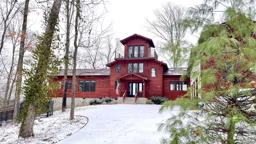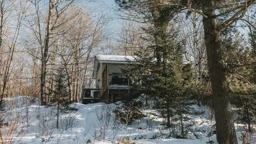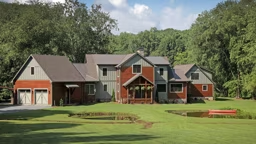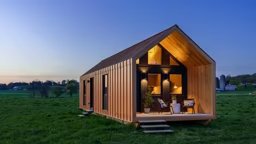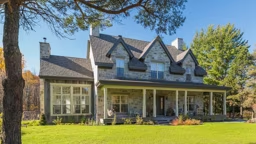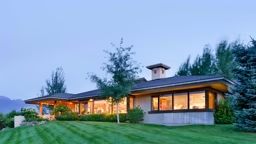Greene by Design
During construction, the Greenes did all they could to preserve the land. For starters, they removed only four trees, total. In addition, to minimize impact on the site. Thom designed the structure 2 feet off the ground. It was placed on 17 treated wood piers with concrete-filled “big foot” plastic footers.
Such environmental considerations came naturally to Thom, a seasoned architect, who upon purchasing the land immediately began drawing up sketches and asking Nadeen for input on space planning and other considerations.
For instance, they knew they wanted an uncluttered cabin, but they weren’t big fans of closets. So Thom designed what he calls “open, organizational storage” – 2x2-foot cubby holes beneath the kitchen’s island where guests can stash their cameras, sunscreen, totes and favorite beverages.
During construction, the Greenes did all they could to preserve the land. For starters, they removed only four trees, total. In addition, to minimize impact on the site. Thom designed the structure 2 feet off the ground. It was placed on 17 treated wood piers with concrete-filled “big foot” plastic footers.
Such environmental considerations came naturally to Thom, a seasoned architect, who upon purchasing the land immediately began drawing up sketches and asking Nadeen for input on space planning and other considerations.
For instance, they knew they wanted an uncluttered cabin, but they weren’t big fans of closets. So Thom designed what he calls “open, organizational storage” – 2x2-foot cubby holes beneath the kitchen’s island where guests can stash their cameras, sunscreen, totes and favorite beverages.
Architectural Nuances
Special thought also was given to the design of the front room’s upstairs alcove, which has a dynamite view of the lake through the large bay window. Thom and Nadeen didn’t want the space to simply be admired (as is the case with cathedral ceilings); they wanted to utilize it.
“We chose to create a whole different dynamic for that space,” says Thom. So he designed a cozy little reading nook, which is accessible only by a bridge. The bridge feels a bit “dock-esque,” says Thom, as the boards flex a bit with each step. The balusters are custom-made powder-coated 5/8-inch black metal rods. Not surprisingly, imaginative children find the bridge pretty nifty, conjuring images of a rustic fort.
The 1,450-square-foot cabin looks like it was built in the 1930s with its metal roof, knotty white pine interior siding (no drywall) and tongue-and-groove white cedar exterior siding. In addition, the chunky white pine posts along the perimeter of the front porch flare at the bottom, each resembling an elephant’s foot.
Special thought also was given to the design of the front room’s upstairs alcove, which has a dynamite view of the lake through the large bay window. Thom and Nadeen didn’t want the space to simply be admired (as is the case with cathedral ceilings); they wanted to utilize it.
“We chose to create a whole different dynamic for that space,” says Thom. So he designed a cozy little reading nook, which is accessible only by a bridge. The bridge feels a bit “dock-esque,” says Thom, as the boards flex a bit with each step. The balusters are custom-made powder-coated 5/8-inch black metal rods. Not surprisingly, imaginative children find the bridge pretty nifty, conjuring images of a rustic fort.
The 1,450-square-foot cabin looks like it was built in the 1930s with its metal roof, knotty white pine interior siding (no drywall) and tongue-and-groove white cedar exterior siding. In addition, the chunky white pine posts along the perimeter of the front porch flare at the bottom, each resembling an elephant’s foot.
Sun Power
The architectural features definitely set apart the Greenes’ place from many others. But even more unusual is the fact that the cabin is powered by the sun. Solar power trickles in from the four 188-watt solar panels that are situated near the edge of the shoreline. These panels, measuring 30x42 square inches each, provides enough energy to the cabin’s 1,000 pounds of batteries to run the lights, ceiling fans, stereo and the well pump for showers and toilets for three days.
“If it’s really cloudy or we have a crowd here, then we may need to use the generator for an hour or two to pump more juice into the batteries,” says Nadeen. The Greenes also have two 100-pound propane tanks (one in use, one for back-up), which run the refrigerator, stove, back-up generator and water heater.
Hidden in a small closet adjacent to the master bedroom is a fancy energy convergent panel that provides digital read-outs on available battery power. The system even has a high-tech protection mechanism that prevents the batteries from draining too low.
The architectural features definitely set apart the Greenes’ place from many others. But even more unusual is the fact that the cabin is powered by the sun. Solar power trickles in from the four 188-watt solar panels that are situated near the edge of the shoreline. These panels, measuring 30x42 square inches each, provides enough energy to the cabin’s 1,000 pounds of batteries to run the lights, ceiling fans, stereo and the well pump for showers and toilets for three days.
“If it’s really cloudy or we have a crowd here, then we may need to use the generator for an hour or two to pump more juice into the batteries,” says Nadeen. The Greenes also have two 100-pound propane tanks (one in use, one for back-up), which run the refrigerator, stove, back-up generator and water heater.
Hidden in a small closet adjacent to the master bedroom is a fancy energy convergent panel that provides digital read-outs on available battery power. The system even has a high-tech protection mechanism that prevents the batteries from draining too low.
Solar by Accident
Although the Greenes love their cabin’s “green” features, they didn’t initially set out to have a solar-powered cabin. During construction, Thom contacted the local electrical company to ask how he could get electricity to the island.
“They were baffled. They hadn’t a clue how to do it, what it would cost, or how difficult it would be,” recalls Thom.
“But you know what? I’m glad it worked out this way. I’m proud of the fact that we’re off the grid.”
“Yeah,” Nadeen adds. “And when a storm blows in and every-one in the area loses power, we’re still glowing!”
Although the Greenes love their cabin’s “green” features, they didn’t initially set out to have a solar-powered cabin. During construction, Thom contacted the local electrical company to ask how he could get electricity to the island.
“They were baffled. They hadn’t a clue how to do it, what it would cost, or how difficult it would be,” recalls Thom.
“But you know what? I’m glad it worked out this way. I’m proud of the fact that we’re off the grid.”
“Yeah,” Nadeen adds. “And when a storm blows in and every-one in the area loses power, we’re still glowing!”
BEST THINGS ABOUT ISLAND LIVING:
The commute. The Greenes typically spend three-day weekends at the cabin, leaving their Chicago home after work on Thursday and arriving to the access site around 11 p.m. The moment they exit the car, they’re at one with nature. “We hop into the canoe and paddle over to the island with the stars twinkling overhead and the loons serenading us,” says Nadeen. “It’s so peaceful.”
Staying put. “Occasionally we’ll venture off the island for some special event – like last year when we toured Leelanau County’s wineries,” says Thom. “But for the most part, when we get to the island, we’re there to stay.”
Light packing. When you have to bring every single item over by boat, there’s added incentive to pack only what you’ll truly need. “We’ve gotten quite good at estimating the necessary amount of food, water and supplies,” says Nadeen.
Creating practical “nature art.” Thom uses fallen white birch branches to mark paths all around the island. “I want all of our visitors to enjoy nature without disturbing it,” says Thom. “These paths allow for both.”
The tranquility. The Greenes love to sit on the front porch and listen to the sound of spring. “It’s so quiet that literally you can hear the popping sound of ferns and other plants pushing up beneath the old, dry leaves,” says Nadeen. “It’s amazing to actually hear new life.”
The commute. The Greenes typically spend three-day weekends at the cabin, leaving their Chicago home after work on Thursday and arriving to the access site around 11 p.m. The moment they exit the car, they’re at one with nature. “We hop into the canoe and paddle over to the island with the stars twinkling overhead and the loons serenading us,” says Nadeen. “It’s so peaceful.”
Staying put. “Occasionally we’ll venture off the island for some special event – like last year when we toured Leelanau County’s wineries,” says Thom. “But for the most part, when we get to the island, we’re there to stay.”
Light packing. When you have to bring every single item over by boat, there’s added incentive to pack only what you’ll truly need. “We’ve gotten quite good at estimating the necessary amount of food, water and supplies,” says Nadeen.
Creating practical “nature art.” Thom uses fallen white birch branches to mark paths all around the island. “I want all of our visitors to enjoy nature without disturbing it,” says Thom. “These paths allow for both.”
The tranquility. The Greenes love to sit on the front porch and listen to the sound of spring. “It’s so quiet that literally you can hear the popping sound of ferns and other plants pushing up beneath the old, dry leaves,” says Nadeen. “It’s amazing to actually hear new life.”
Nothing beats the chaotic fun of huge family gatherings at the cabin where fresh air, good food and fired-up kids all converge, and there’s fishing, swimming, boating, eating and playing.
Though the Greenes relish this wild tradition, five years ago they instituted a new one they call “Sibling Weekend,” which includes Thom’s two siblings and their spouses. They engage in fake fishing tournaments, play games of horseshoes, hike the island, indulge in long cocktail cruises in the pontoon boat and spend countless hours around the fire pit. The main goal during Sibling Weekend is to just “chill out.”
Freelancer Christy Heitger-Casbon writes from her home in Indiana while dreaming of her own family cabin in Michigan.
Though the Greenes relish this wild tradition, five years ago they instituted a new one they call “Sibling Weekend,” which includes Thom’s two siblings and their spouses. They engage in fake fishing tournaments, play games of horseshoes, hike the island, indulge in long cocktail cruises in the pontoon boat and spend countless hours around the fire pit. The main goal during Sibling Weekend is to just “chill out.”
Freelancer Christy Heitger-Casbon writes from her home in Indiana while dreaming of her own family cabin in Michigan.
Thom and Nadeen Greene adore their 1910 Prairie-style Chicago home, but living in a neighborhood with 100,000 people made them crave a little personal space. So in 1998, they purchased a 5-acre island on a quiet 400-acre inland lake in Grand Traverse County, Mich. The Greenes were immediately captivated by the island’s abundance of pine, cedar, maple and birch trees.
“We like to think of it as having traded the concrete high-rises of Chicago for the 90-foot white pine skyscrapers of Greene Island,” says Thom.
“We like to think of it as having traded the concrete high-rises of Chicago for the 90-foot white pine skyscrapers of Greene Island,” says Thom.





 Brian Confer
Brian Confer 



